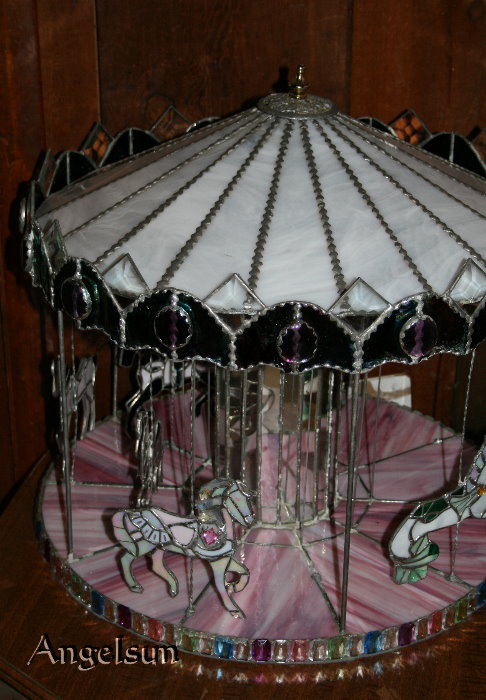September 2, 2010

The "dark horse". :) He is made from irridized black glass and you can really see the reflective properties of the glass in this photo. Although I love pastels; I'm VERY fond of this particular horse. He was modeled after one of Muller's carvings. Muller was known for his realistic poses, a pompadour style of forelock, and for postitioning the eyes to
look back at the rider. The model was carved in 1917 and is at Cedar Point, Sandusky, OH.

Another shot of the Muller "dark horse".

This horse is modeled after a carving by Marcus Illions and is made prmarily from irridized bronze transluscent glass. This photo captures a little of the rainbow effect produced by the flashing on the irridized surface. Illions was born in Russia but trained in England with John Savage. He also trained with Looff and supplied many of the fantasy horses seen at Coney Island.
The real model for this horse was carved in 1914 and resides in Wyandot Lake Park in Powell, OH.

This is an afghan hound that I designed for the carousel. I need to get the correct gauge of wire to twist and attach to it. The horses on the carousel can be moved and changed. So, I'll have the option to use this piece and I want to design a poodle as well--maybe some special seasonal things too.

This is a very petite horse but I am really fond of him too. I am a sucker for pastels. :) This horse is a "prancer" having the rear legs planted on a platform. It was made prior to the "jumping mechanism" which was invented in 1907 by John Savage. He is modeled after a horse by German carver Freidrich Heyn--the earliest carousel manufacturer who opened his factory in 1870. Heyn was known for sweet expressions and elaborate manes. The real model for this horse was carved in
1900 and resides in Windmill Island Park, Holland, MI. It was also offered as a child's rocking horse.

These horses are completed. I now have all of the gems back on the other horses and they are drying. Awaitling my "solder sucker" to get the support tubes unplugged and then the rest of the horses can go back on. I'm going to add some colored mirror tiles on the center mirrored support. Although I sealed the mirror pieces, some of the silver backing looks chipped or aged. I think that the tiles will add a pretty touch. It makes me
happy to see the carousel almost back to where it was when I made it in 1994.

This is the fantasy horse that I chose for the carousel. It is a mer-horse or hippocampus (combination of horse and fish). Maybe what mermaids (or hot mermen) ride?? They are very rare and fewer than 5 examples by each carver exist. The model
for this one resides in a private collection and was carved between 1900-1905.

The white crud rears it stubborn head again. Since I'm working inside, I used Windex instead of straight ammonia. Always liked the looped design on the hindquarters. This is a Looff horse--described as an "amiable mount--never a threat to children". I'm not fond of the bared teeth ones myself--some of them are downright scary!! This handsome fellow wears a German stylized harness accented with lots of jewels and bling. The
real model was carved in 1912 and on the Santa Cruz Beach Boardwalk in Santa Cruz, CA.

Here's the last three horses of the carousel (Looff, P.T.C., Illions), cleaned and ready to have gems applied.

Setting gems with E-6000 and tweezers on the Illions horse.

Adjusting the eye gem on the Looff horse with a toothpick.
I love my bangles!! They are from Beachcombers Bazaar

I decided to put lots of gems on this horse--now to be known as the "bling" horse. LOL This is a P.T.C. with a whipping mane and a tail that was doweled to the rear leg.
The real model was carved in 1915 and on the Santa Monica Pier in Santa Monica, CA.
| 

























